When you’re stranded in the woods, who you gonna call?
share

STEAMBOAT SPRINGS, Colo. — An injured hiker lay at the bottom of a gully just below Rabbit Ears peak. Even if he was able to walk on his own, the 45 degree slope was too steep to climb. If he didn’t evacuate soon, the situation could have easily gone from bad to worse.
Within 28 minutes of arriving on the scene, members of the Routt County Search and Rescue team rappelled into the gully, assessed the patient’s condition and devised a pulley system to hoist him to safety.
Thankfully, today’s mid-July scenario was training, but tomorrow, members of the volunteer rescue team could respond to any number of equally serious situations.
“Nobody goes out to get injured or get lost. It just happens. And that's why we want to be there to help these people, no matter how big or how small it might be,” said Kristia Check-Hill, who joined the search and rescue team in 2001.
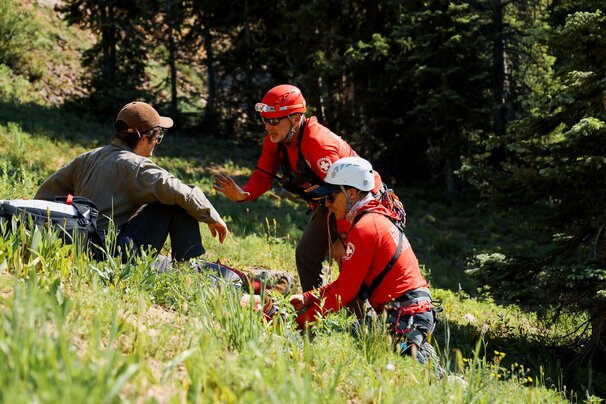

After rappelling into a gully, John Williams (first photo, middle) and Tim Wohlgenan (first photo, right) perform a patient assessment during a search and rescue training exercise on Rabbit Ears Pass. Silas Axtell plays an injured hiker.
Photo: Cormac McCrimmon, Rocky Mountain PBS
Photo: Cormac McCrimmon, Rocky Mountain PBS
According to data from the 2019 Statewide Comprehensive Outdoor Recreation Plan, “approximately 92% of Coloradans recreate outdoors at least once every few weeks.”
As more people go outside, more will require assistance when they get lost or injured. According to a 2022 study by Colorado Parks and Wildlife, Colorado backcountry search and rescue teams currently respond to 3,600 incidents per year. Over the course of a year, teams respond to emergencies like hypothermic hikers to avalanche burials and hunting accidents.
In response to the increased demands on backcountry search and rescue teams, the Colorado Senate passed Bill 21-245 in 2021, which provided additional funding to these teams. Still, backcountry search and rescue teams rely almost exclusively on volunteers, who remain ready to respond the moment they receive a call.
A group of local residents formed Routt County Search and Rescue (RCSAR) in 1968. According to the organization, it started as a “small group of local men who would be called by their friends to come and help them get unstuck in the backcountry when they were snowmobiling.”
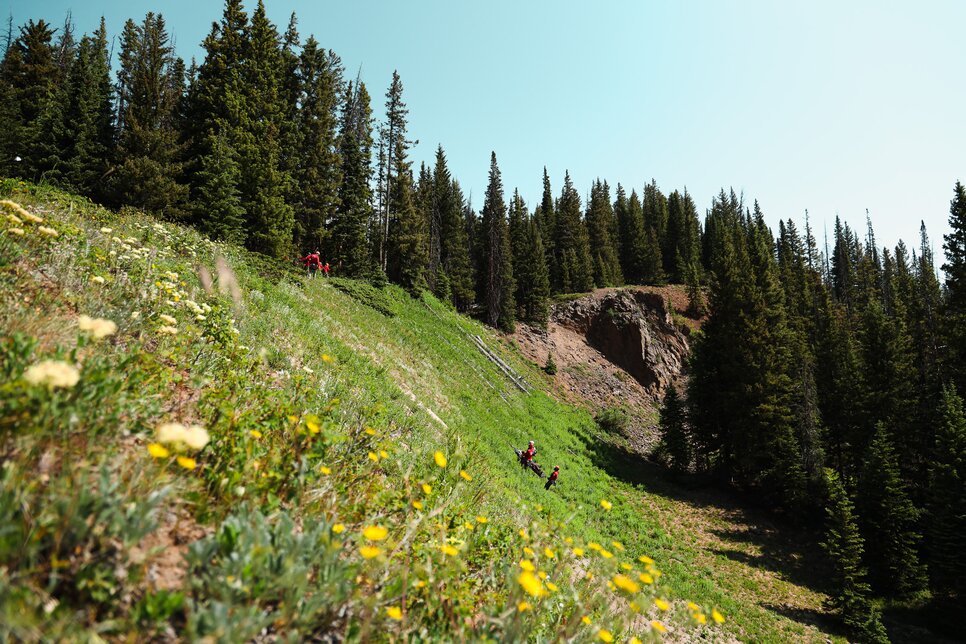
Members of Routt County Search and Rescue perform a steep angle rescue during a training on Rabbit Ears Pass.
Photo: Cormac McCrimmon, Rocky Mountain PBS
To this day, RCSAR operates as a nonprofit organization under the jurisdiction of the Routt County Sheriff’s Department. Like nearly every backcountry search and rescue team in the state, the organization is wholly dependent on volunteers.
When someone calls 911 for a backcountry emergency, an incident commander for RCSAR coordinates with other first responders, including local fire districts, a medical helicopter or ski patrol, to launch a response. Each year the organization conducts approximately 60 missions.
Check-Hill is one of the group’s longest standing members.
“I never thought in a million years that this would be something I'd be doing,” she said.
She grew up in Newport Beach, California.
“My parents took us camping every summer up in the Sierras. And so I grew up camping and hiking and fishing, riding motorcycles. I probably could ride a motorcycle before I could ride a bike,” said Check-Hill.
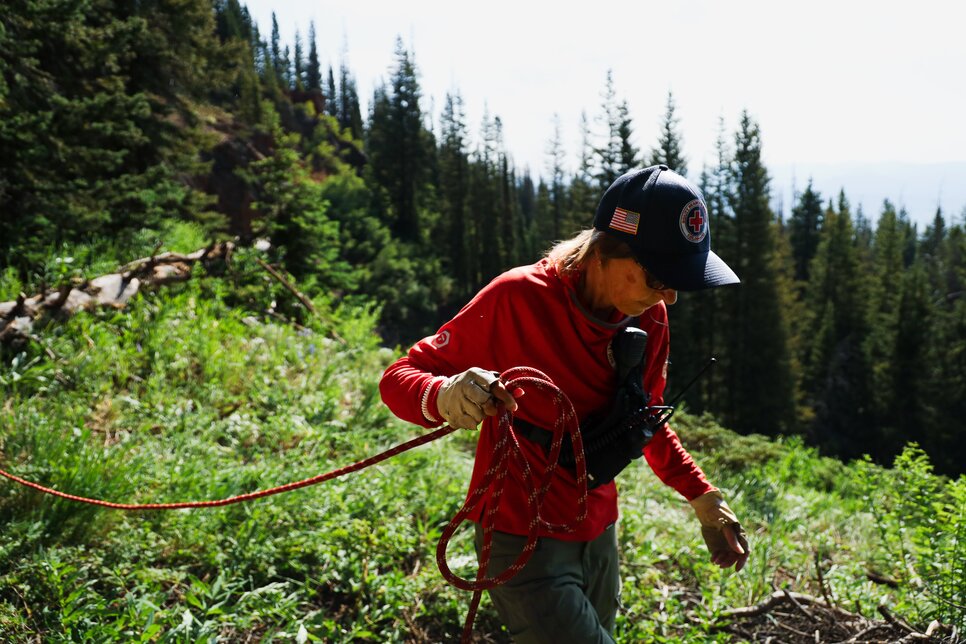
Kristia Check-Hill works to construct a pulley system to extract an injured hiker.
Photo: Cormac McCrimmon, Rocky Mountain PBS
But when she joined the team in 2001, Check-Hill said she “had no real skills.” She learned through experience and by working alongside some of the group’s founding members. In her time with the team, she’s seen search and rescue change dramatically.
“When I started, we used paper maps, compasses. We didn't use computers, we didn't have radios, we didn't have cell phones,” said Check-Hill.
Although technology can help backcountry search and rescue teams to locate victims more precisely and better predict weather and terrain conditions they may encounter, technology also changes where and how people recreate.
“People are recreating further into the backcountry, using bigger, better machines to get back there,” said Check-Hill.
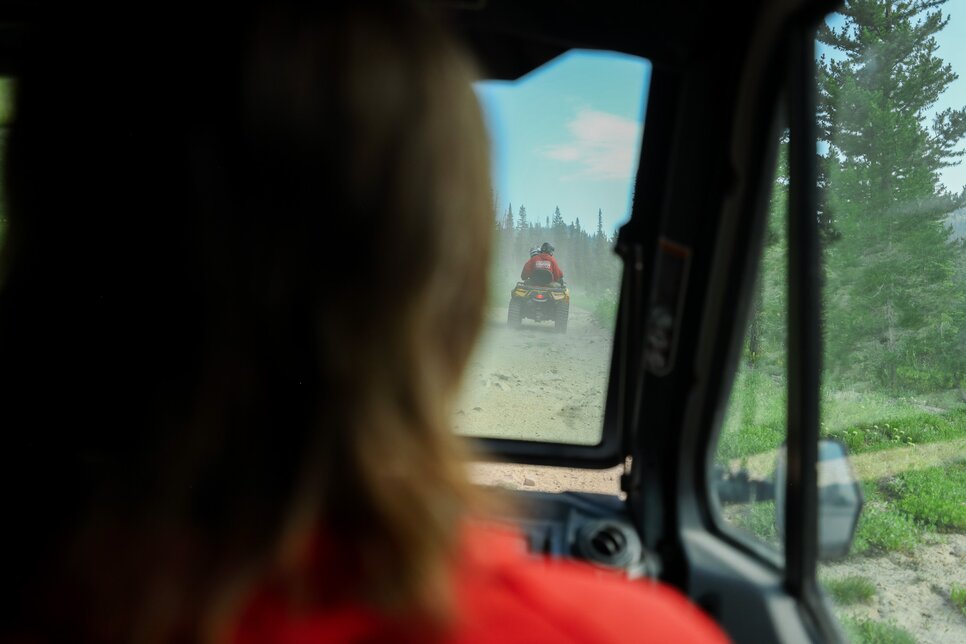
Because of the large area the team must cover, they are highly dependent on ATVs and snowmobiles.
Photo: Cormac McCrimmon, Rocky Mountain PBS
Photo: Cormac McCrimmon, Rocky Mountain PBS
By 8:15 a.m. Sunday, a dozen members of the group had assembled at the top of Rabbit Ears Pass. Mosquitos swarmed the group, eager to break their fast.
Matt Karzen, the team’s training director and the county district attorney, passed around a box of donuts. The team also includes a retired doctor, a former fishing guide and an outdoor gear repair specialist.
According to Harry Sandler, a board member and team leader, one of the biggest challenges is finding members who are available to drop everything for a mission.
If you’re waiting tables, “you can't just tell the other server, hey, you got my section, I gotta go, that doesn't work too well,” Sandler said.
Although team members don’t have to participate on every mission, joining the team requires a significant time commitment that necessitates buy-in from employers or a flexible work schedule.
“I joke that this is my full-time unpaid job,” said Check-Hill, who works part-time as an accountant.
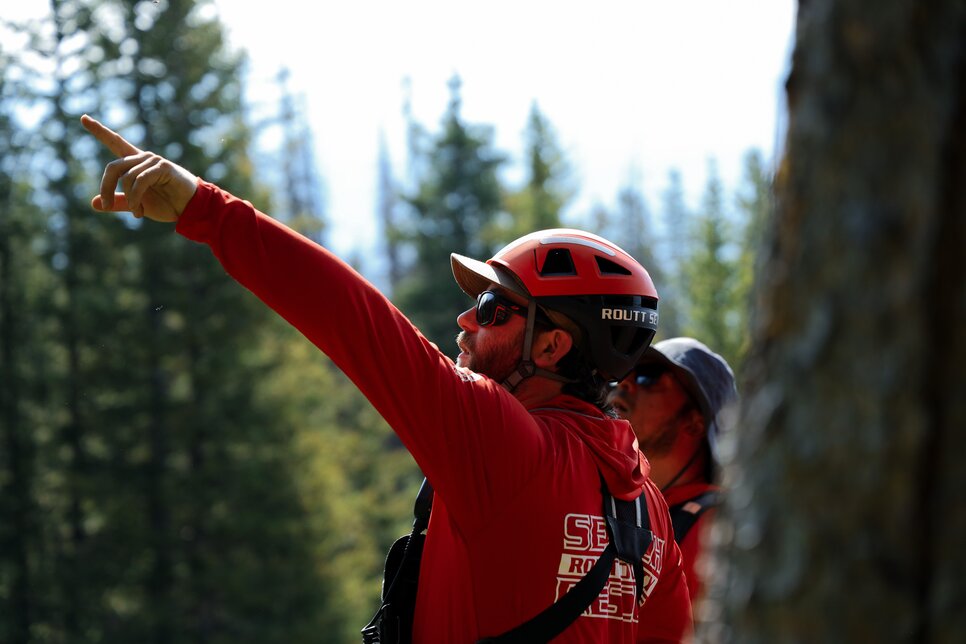
Harry Sandler identifies a hazard as the team constructs an anchor during training.
Photo: Cormac McCrimmon, Rocky Mountain PBS
After loading climbing equipment and rescue apparatus on ATVs, the group blazed through a sea of fireweed to the top of the pass. When they reached the mock rescue site, the team discussed their plan of attack and how to manage nearby hazards, including a dead tree.
“We risk a lot to save a lot. We risk nothing to save nothing,” said Michael Boatwright, a team member. In order to avoid adding to the number of victims, rescuers must prioritize their own safety, especially during body recovery missions.
Despite the team’s mix of strong personalities, they quickly forged their individual intensities to address the task at hand.
“These are some of the most humble people I know. No one has an ego,” said Curt Calcaterra, a retired internal medicine doctor, who couldn’t say the same about other teams he’s worked on.
Bobby Carlton, the president of the organization, credits this to the team’s focus on inclusion and collaboration.
“It's team, team, team. We are not individuals here,” said Carlton. “I've never really seen anybody being berated for anything here. We break stuff all the time. If you break something, you might get your name plastered on it. But it’s all in good fun, right?”
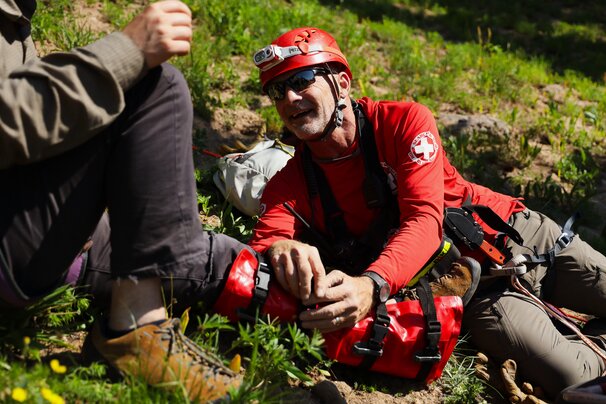

First photo: John Williams provides patient care during training. Second photo: A team member uses climbing equipment to secure a litter before extracting a patient during training.
Photo: Cormac McCrimmon, Rocky Mountain PBS
Photo: Cormac McCrimmon, Rocky Mountain PBS
Backcountry search and rescue needs vary widely by county. For example, RCSAR relies heavily on ATVs and snowmobiles to cover lots of ground quickly. But, other counties, such as Summit County, respond to more avalanche and peak climbing accidents.
According to Sandler, RCSAR receives roughly half of its funding from the City of Steamboat Springs and Routt County. The other half comes from a patchwork of state and local grants and private donations.
Although there are always items the team wishes it could afford — replacing aging vehicles or covering the cost of specialized training, for example — RCSAR has a strong network of donors. Teams based in less affluent areas aren’t so lucky. If funding stalls, the consequences could be severe.
“Search and rescue never charges. Sometimes we hear, ‘I didn't want to call because I was afraid I was going to get a bill.’ Well, then that creates maybe a bigger problem because now it's dark or the injury gets worse or, you know, you can just see the cascading effect,” said Check-Hill.
“If the funding doesn't continue, and especially for teams that are out there that are not as fortunate as we are with the stuff that they have and the funding that they can get, somebody could really get hurt out there.”